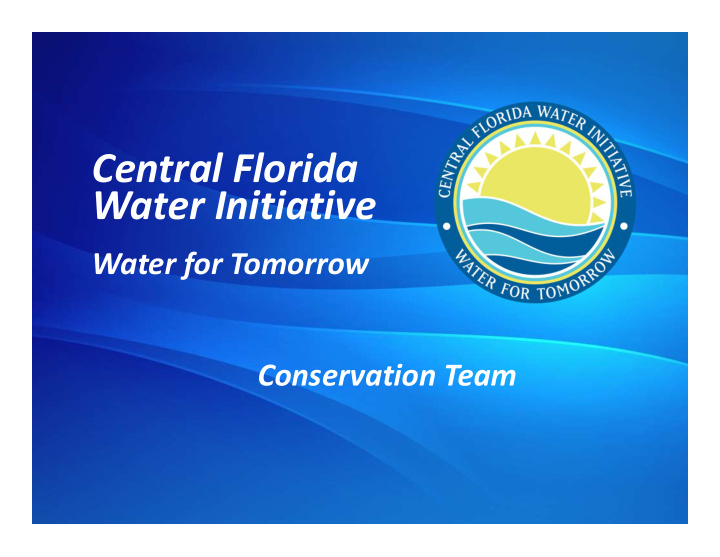



Central Florida Water Initiative Water for Tomorrow Conservation Team
Conservation Team Overview Goal: – Collaboration to continue the effort to advance conservation beyond the estimates established in the RWSP Objectives: – Develop options for an implementation strategy to achieve greater than the 37 MGD of water savings identified in the 2015 CFWI RWSP. – Update the water conservation estimates for achievable water conservation, and produce a draft Water Conservation Chapter for the 2020 CFWI RWSP which summarizes the work and analysis of the Conservation Team.
Conservation Implementation Strategy Quantification Efforts
Public Supply – Individually Quantified Conservation Four quantifiable programmatic savings: 1. The Florida Water Star Rebates or Requirement 2. The Extension Agent/Florida Friendly Program 3. Florida Green Building Coalition (FGBC) Homes 4. Quantified Irrigation Restriction Enforcement 0 5 10 15 20 25 30 Individually Quantified Conservation
Public Supply – District Cost-Share • District cost-share projects were evaluated for the 2010-2018 period. – Overlap from survey results were deducted • In addition to the 10 Quantified BMPs in the 2015 RWSP, the cost share projects also include other measures, such as AMI Implementation, line flushing, conservation software, behavioral programs, etc. 0 5 10 15 20 25 30 Individually Quantified Conservation District Cost-Share Projects
Public Supply – Survey BMPs • The 12 utilities responding to the BMP quantification portion of the survey represent 67% of the PS 2035 demands based on projections in the 2015 plan. – The estimated savings for only the 12 utilities responding represents the low end of the savings range, while the high end of the range extrapolates the savings to the entire CFWI region. 0 5 10 15 20 25 30 Individually Quantified Conservation District Cost-Share Projects Public Supply Survey BMPs- low estimate Public Supply Survey BMPs - high estimate
Public Supply Total Est. & Projected Savings through 2019 : 9.77 mgd 27.91 mgd 0 5 10 15 20 25 30 Individually Quantified Conservation District Cost-Share Projects Public Supply Survey BMPs- low estimate Public Supply Survey BMPs - high estimate Future Conservation Savings Needed to meet Projection
Agriculture Self Supply USDA NRCS – Programs that compensate agricultural producers and landowners that voluntarily implement practices that protect soil, water, air, wildlife habitats, and related natural resources. Soil and Water Conservation Districts – Mobile Irrigation Labs (MILs) are used to ensure irrigation systems are operating optimally. Verified results are available from FDACS. Estimated and Project Conservation Savings 2010-2017 mgd 1 0 0.5 1 1.5 2 2.5 3 3.5 4 4.5 5 NRCS Soil and Water Conservation District (MILs)
Agriculture Self Supply District Programs: SWFWMD • FARMS Program assists with implementation of BMPs related to reducing groundwater demands from the Upper Floridan aquifer in agricultural areas. SJRWMD • Agricultural Cost-Share Program focuses on increasing irrigation efficiency through partnership efforts. SFWMD • Agricultural producers have not historically taken advantage of SFWMD cost-share opportunities for this region 1 0 0.5 1 1.5 2 2.5 3 3.5 4 4.5 5 NRCS Soil and Water Conservation District (MILs) SJRWMD SWFWMD
Agriculture Total Estimated and Project Conservation Savings 2010-2017 mgd 1 Estimated and Projected Savings: 3.49 mgd 4.30 mgd 0 0.5 1 1.5 2 2.5 3 3.5 4 4.5 5 NRCS Soil and Water Conservation District (MILs) SJRWMD SWFWMD Conservation savings needed to meet Projection
Other Self Supply • The OSS category shifted from looking at Indoor PS-Type conservation measures to demand specific measures • Methodology to quantify savings based on a permit-specific review of conservation plans • OSS has realized 1.3 mgd of the projected savings so far.
Domestic Self Supply • Water use within this category is expected to increase by approximately 20% from 20.36 mgd in 2010 to 24.42 mgd in 2035. • The 2015 CFWI RWSP identified 1.19 mgd of water conservation potential for this water use sector. • Though passive conservation is anticipated, water savings to achieve projected conservation to come from outdoor irrigation restrictions, local ordinances, regional conservation messaging and similar.
Total Quantified Savings by Sector 40 35 30 25 20 15 10 5 0 Public Supply (projected through 2019) Agriculture (projected through 2017) OSS (excluding DSS) Total of Listed Sectors Quantified Conservation Savings since 2010 (mgd) Remaining Conservation Savings to Meet 2035 Projection Needed
Next Steps Goal Topic Deliverable Develop a survey to document conservation efforts being Golf course survey made by Golf Courses Review and contribute to a white paper on agricultural BMPs Agriculture White Paper for ultimate review and approval by the Steering Committee Designate a Conservation Messaging Liaison to work with the Communications and Outreach Team to develop a white paper about how to message water conservation for various Conservation Outreach audiences to maximize behavior change. and Communication Identify funding sources, conservation messaging, and target audiences as well as other outreach opportunities, such as trainings, workshops, etc. Identify guideposts that can be included in the conservation Guideposts chapter of the 2020 RWSP Passive Conservation Estimate passive conservation savings for the 2020 RWSP. Continue to work with stakeholders to develop designated Project Options projects for the 2020 RWSP. Further define "geographic target areas," and generate maps to Geographic Target Areas depict the areas
Next Steps continued Goal Topic Deliverable Develop/finalize savings estimates for new BMPs including: BMP irrigation restriction enforcement, rain sensors, customer Improvement/Expanded portal/AMI, and irrigation system audits. Identify additional Effort BMPs with goal to increase rate of implementation. Future iterations of this implementation strategy shall undertake a review of cost-share applications in each district, Cost-Share Participation evaluate which eligible users are utilizing cost-share Review programs for conservation and identify how additional eligible applicants can be encouraged to apply for cost-share funding to implement larger conservation efforts. Data Source Improvement Improve data collection and analysis.
2020 CFWI Conservation Projections
Projected 2040 Projected 2040 Conservation Demand (mgd) Savings Estimate Water Demand Category (mgd) Public Supply 592.28 41.50 – 44.16 Domestic Self-Supply (DSS) 24.59 0.86 Agriculture 163.49 4.19 Landscape/Recreational 49.27 2.22 Commercial/Industrial/Institutional 69.00 1.55 - 4.40 Power Generation 11.27 Total 909.9 50.32 – 55.83
Questions?
Recommend
More recommend